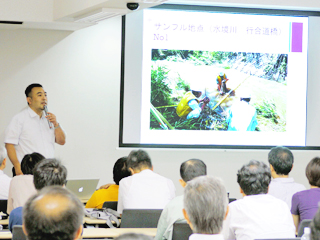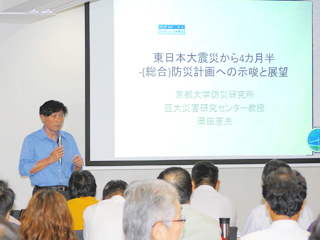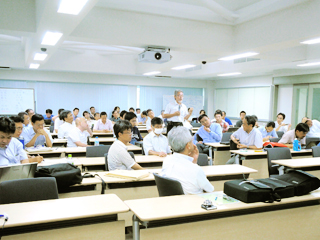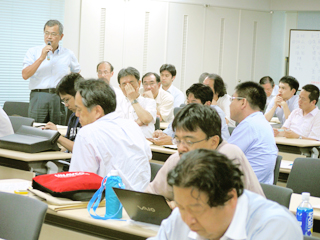Kyoto University Symposia Series VII ("Great Earthquakes and Tsunamis [Part One]-- The DPRI's Emergency Report Session on the Great East Japan Earthquake") was held at the conference hall in the Cooperative Research Building of Kyoto University's Disaster Prevention Research Institute (DPRI).
On March 11, 2011 at 2:46 p.m., a magnitude 9.0 earthquake occurred off the coast of Sanriku. On March 12, the day after the disaster, DPRI established its Action Planning Headquarters for the 2011 Great East Japan Earthquake in order to provide information on damage surveys and analytical data. In response to the disaster, it ensured coordination within the institute and with relevant external organizations in the areas of crisis management for investigative activities, recovery support, and joint investigations. The institute also conducted an immediate investigation in an effort to grasp an accurate picture of the damages sustained and to identify issues for future research while actively participating in activities to support the stricken area. Now that roughly four months have passed and some academic knowledge has become available providing a complete picture of the earthquake disaster, DPRI organized this symposium to publish part of its achievements and to discuss the direction of future research.
The symposium, which also served as the opening event for the conference hall of the Cooperative Research Building, was attended by a full-capacity audience. At the event, Professor Hajime Mase, Professor Tomotaka Iwata, Professor Toshitaka Kamai, Associate Professor Yosuke Yamashiki, Associate Professor Norio Maki, and Professor Norio Okada gave presentations that painted a complete picture of the tsunami and landslide damages as well as characteristics of the earthquake, reports on investigations regarding the dynamics of radiation, and lectures about the current status of the government's response and problems.
After the lectures, participants--including students and professors--came together to have group discussions, the first such attempt in the symposia series. It was expected that discussions beyond the barriers of generations and disciplines would yield meaningful and innovative suggestions free from the constraints of conventional ideas. As an indication of the keen sense of crisis triggered by the great earthquake--especially among young researchers--some of them passionately challenged senior faculty members to debate on the essential issue of how the university's research achievements could be used for society, which heated up the discussions even beyond the organizer's expectations. During the general discussion at the end of the event, participants expressed views such as "now the functions of research institutes affiliated with universities are questioned; we need to promptly tackle this situation head on." Participants renewed their commitment to their work for safeguarding the nation against the risks of great disasters expected to occur in the near future such as the next Nankai and Tonankai earthquakes. Based on the discussions that participants had at the symposium, the institute will propose the future direction of its research on disaster prevention under the primary initiative of its Research Planning and Promotion Office.
On September 13 and 14, the session of the institute's symposia series (series X) will be held, titled "Considering Disaster Risk Reduction in the Post-Great-Earthquake Age: Future Disaster Risk Reduction Learning from the Experience of the 2011 Great East Japan Earthquake" (the 48th General Symposium on Natural Disaster Research). On September 29, the institute will also host its symposia series IX event ("Great Earthquakes and Tsunamis [Part Two]--How Can We Face a Mega Disaster?: Estimations and Their Limits"), DPRI's 2011 open lecture.
 Lecture by Associate Professor Yamashiki |  Lecture by Professor Okada |
 Emergency Report Session (1) |  Emergency Report Session (2) |
 Emergency Report Session (3) | |

